Working Offshore
Rigs
There are many different types of rig including:
 Production
platform
Production
platform
Production platforms are permanent, immobile structures built on steel
and/or concrete legs that are fixed directly onto the seabed. They are
the largest type of structure you would work on offshore. They are
built once oil or gas (hydrocarbon) has been found in commercially
produce-able quantities and although further drilling will often take
place on the platform, its main purpose is producing the hydrocarbon.
Often, a single platform will gather hydrocarbon from a number of
outlying wells through what are known as ‘tiebacks’ – a network of
valves and pipes that rest on the sea bed.
 Semi
Submersible
Semi
Submersible
Platform Semi-submersible platforms or rigs are floating (mobile)
structures used for drilling for oil and natural gas in offshore
environments. They have a number of pontoons and/or columns that are
flooded with seawater, causing the installation to sit very low in the
water, providing the stability that is required for drilling
operations. The unit is fixed in position with very large mooring
anchors and is moved from location to location by tugs. These types of
installation can drill in very deep, rough water due to their
excellent stability.
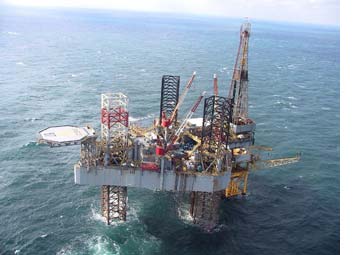 Jack-up
Rig
Jack-up
Rig
A Jack-up rig is a self-contained combination drilling rig and
floating barge, which has been fitted with long legs that are raised
when moving and lowered to the sea bed when on location. The rig is
limited to operating in water depths of a maximum of about 400 feet
(depending on the rig) – which is sufficient for many parts of the
North Sea. Like the semi-submersible it is moved from location to
location by tugs.
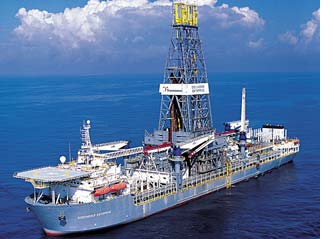 Drill
Ship
Drill
Ship
A Drill ship is a maritime vessel that has been fitted with drilling
equipment. They can move under their own power and, though not as
stable as semi-submersible platforms, they can drill in deep water. A
drill ship is held in position over the well by a combination of its
own engines turning powerful screws in the hull and global positioning
satellite (GPS) technology.
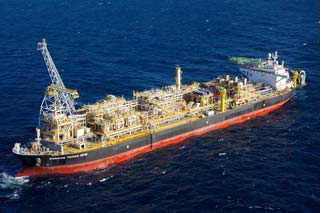 Floating
Production and Storage Offloading Vessel (FPSO’s)
Floating
Production and Storage Offloading Vessel (FPSO’s)
A FPSO is a type of floating tank system used by the offshore oil and
gas industry. They are often converted oil tankers – although
increasingly they are purpose built – which attach to a sea bed
wellhead from which they produce and store the oil. The oil is then
offloaded to another tanker for transport to the refinery. They are
particularly used for production from small reservoirs where it would
be too expensive to build a production platform – one of the major
advantages is that the FPSO is re-usable as it can be moved from well
to well.
Flotels
Flotels are literally floating accommodation units. They are quite
often converted from semi-submersible platforms; these are then moored
alongside a production platform or other type of rig, and connected to
them via a long gangway. This is one way of keeping the accommodation,
leisure and catering facilities remote from the working areas which is
a legal requirement in the North Sea.
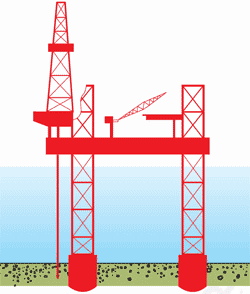

Jack-up Rig Steel Production Platform


Semi-submersible Rig Concrete Production Platform
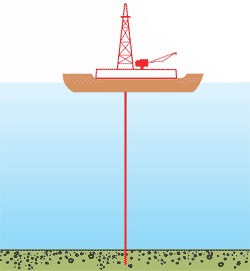

Drillship Tension Leg Platform
Work
 Getting
to work
Getting
to work
Reaching the offshore installation you’re working on generally
involves flying by helicopter. Where the installation is located
around the coast of Britain will dictate where you fly from, but for
all the central and northern North Sea installations, the departure
point is Aberdeen. The generous time off allowances dictated by the
working pattern means you can live all around the country and not just
in Aberdeen and its surrounding areas.
The helicopters used for offshore travel usually have 18 seats,
although smaller helicopters may be used for inter-platform transfers.
Nevertheless the same stringent safety regulations apply. For example,
you must wear immersion suits and lifejackets at all times and before
every single flight there will be a safety briefing including a
detailed video.
Click here to learn more about the offshore survival certificate that
every offshore worker must have.
Working hours
The usual working pattern for most people offshore is 12 hour shifts.
Not all shifts change at the same time, however, so you will need to
find out when you apply for a position exactly what the working
pattern is.
In the North Sea it is normal to spend two or three weeks offshore and
then two or three weeks onshore – whether you work 2/2, 2/3 or 3/3
depends on the company you work for. In a contracting company, it
depends on the company they are providing your services to. In the
Well Services sector, the work is more ad hoc with very few staff
having regular rotation schedules. Generally speaking holiday
entitlement is included in the time off. However, different companies
have different arrangements, so you should check at the time you
apply.
In other parts of the world the work trips may be longer – perhaps
four or even six weeks – but your time ashore (or ‘on the beach’ as it
is known) would be correspondingly longer as well.
 Working
at height
Working
at height
Some jobs, such as drilling from a hydraulic workover unit, or as an
abseiler on rig inspection and maintenance, involve working at height.
However, in all cases there are stringent safety regulations including
the use of appropriate protective equipment. In this picture, these
men are replacing a lifeboat winch assembly.
Benefits
There is a public perception that working in the oil and gas industry
– particularly offshore – is extremely well paid, but something you do
only for a short time. It is true that the industry does pay well,
especially given the offshore work pattern of two weeks on and two or
three weeks off, although the differential with other industries is
not as large as you might think.
What it most certainly isn’t, is a short term prospect. Indeed, many
workers in the UK sector of the offshore North Sea oil industry have
over 20 years service. So you can see that this is a very experienced
workforce.
Furthermore, although most of the major oil and gas reservoirs in the
North Sea have been tapped, the improvement in technology is allowing
the industry to produce from smaller, more marginal reservoirs and to
significantly extend the working life of most of the existing
production facilities. There will be jobs in the North Sea oil
industry well into the foreseeable future as well as opportunities for
skilled and experienced workers in other parts of the world.
Salaries
Most jobs in the Oil & Gas industry offer a generous renumeration
package, with salaries varying from company to company.